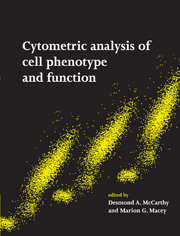Book contents
- Frontmatter
- Contents
- List of contributors
- List of abbreviations
- 1 Principles of flow cytometry
- 2 Introduction to the general principles of sample preparation
- 3 Fluorescence and fluorochromes
- 4 Quality control in flow cytometry
- 5 Data analysis in flow cytometry
- 6 Laser scanning cytometry: application to the immunophenotyping of hematological malignancies
- 7 Leukocyte immunobiology
- 8 Immunophenotypic analysis of leukocytes in disease
- 9 Analysis and isolation of minor cell populations
- 10 Cell cycle, DNA and DNA ploidy analysis
- 11 Cell viability, necrosis and apoptosis
- 12 Phagocyte biology and function
- 13 Intracellular measures of signalling pathways
- 14 Cell–cell interactions
- 15 Nucleic acids
- 16 Microbial infections
- 17 Leucocyte cell surface antigens
- 18 Recent and future developments: conclusions
- Appendix
- Index
- Plate section
1 - Principles of flow cytometry
Published online by Cambridge University Press: 06 January 2010
- Frontmatter
- Contents
- List of contributors
- List of abbreviations
- 1 Principles of flow cytometry
- 2 Introduction to the general principles of sample preparation
- 3 Fluorescence and fluorochromes
- 4 Quality control in flow cytometry
- 5 Data analysis in flow cytometry
- 6 Laser scanning cytometry: application to the immunophenotyping of hematological malignancies
- 7 Leukocyte immunobiology
- 8 Immunophenotypic analysis of leukocytes in disease
- 9 Analysis and isolation of minor cell populations
- 10 Cell cycle, DNA and DNA ploidy analysis
- 11 Cell viability, necrosis and apoptosis
- 12 Phagocyte biology and function
- 13 Intracellular measures of signalling pathways
- 14 Cell–cell interactions
- 15 Nucleic acids
- 16 Microbial infections
- 17 Leucocyte cell surface antigens
- 18 Recent and future developments: conclusions
- Appendix
- Index
- Plate section
Summary
History and development of flow cytometry
Wallace Coulter, in 1954, first described an instrument in which an electronic measurement for cell counting and sizing was made on cells flowing in a conductive liquid with one cell at a time passing a measuring point. This became the basis of the first viable flow analyser. Kamentsky et al. (1965) described a two-parameter flow cytometer that measured absorption and back scattered illumination of unstained cells and this was used to determine cell nucleic acid content and size. This instrument represented the first multiparameter flow cytometer; the first cell sorter was described that same year by Fulwyler (1965). Use of an electrostatic deflection ink-jet recording technique (Sweet, 1965) enabled the instrument to sort cells in volume at a rate of 1000 cells per second. By 1967, Van Dilla et al. exploited the real volume differences of cells to prepare suspensions of highly purified (>95%) human granulocytes and lymphocytes.
It is only comparatively recently that advances in technology, including availability of monoclonal antibodiesand powerful but cheap computers, have brought flow cytometry into routine use. Previously, microscope-based static cytometry with cell-by-cell analysis had been the mainstay of most diagnostic work. However, with the increasing ability to measure a minimum of five parameters on 25 000 cells in 1 second, cell surface antigen analysis has become almost routine. This has not only enhanced the diagnosis and management of various disease states but also given new understanding to the pathogenesis of disease.
Principles of flow cytometry
All forms of cytometry depend on the basic laws of physics, including those of fluidics, optics and electonics (Watson, 1999).
- Type
- Chapter
- Information
- Cytometric Analysis of Cell Phenotype and Function , pp. 1 - 14Publisher: Cambridge University PressPrint publication year: 2001

